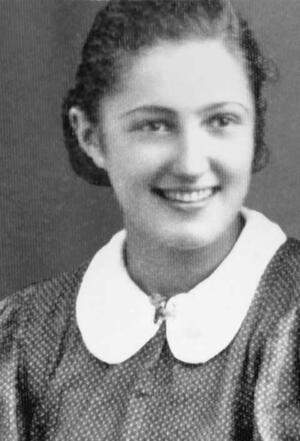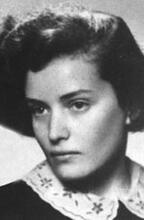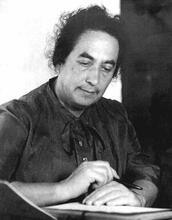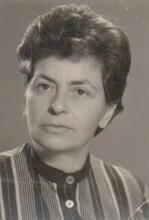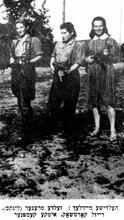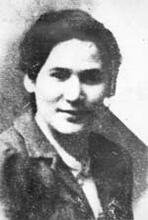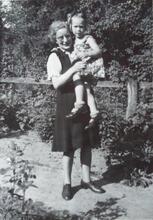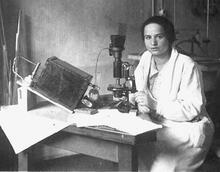Rivka Kuper Liebeskind
Rivka Liebeskind was born in Poland and joined the Akiva Zionist movement as a teenager, becoming a leader in her local chapter. She remained in Warsaw despite the German occupation and traveled for the movement, encouraging members to continue their activities. She worked as a hygienist in the Warsaw ghetto and stayed with the movement when it became an underground resistance group in August 1942. She traveled extensively to communicate messages and helped young people escaping from the ghetto. Arrested at the end of 1942, Liebeskind was deported to Birkenau, but survived thanks to members of the movement who were also imprisoned at the camp. She worked as a teacher at a Jewish school in Sweden before moving to Israel.
Early Life
Rivka Spiner was born on June 15, 1920 in Rzeszów, Poland, to a middle-class religious Zionist family. Her father, Hayyim Spiner (1890–1943), was active in Ha-Po’el ha-Mizrachi, as was her mother, Hadassah (1890–1943). She also had a younger brother, Menahem (1923–1943).
After Rivka Spiner completed elementary school in Rzeszów in 1934, her family moved to Krakow where she attended the Hebrew Gymnasium, graduating in 1938 with a Hebrew-Polish diploma. Though her father had enrolled her in the Ha-Shomer ha-Dati youth movement in Rzeszów, in Krakow she became attracted to the Akiva movement and joined it when she was fourteen. She became a counselor the following year, joined the local group’s leadership at seventeen and envisioned Lit. "ascent." A "calling up" to the Torah during its reading in the synagogue.aliyah to The Land of IsraelErez Israel.
The movement opposed her attending university, demanding that she devote herself completely to its activities. She was required to work in the leadership in Warsaw and six months later was sent to establish groups of youth who studied and worked in Bydgoszcz, Skarzysko-Kamienna, and Starczewice. Her last activity prior to the outbreak of World War II was at the movement’s major summer camp at the foot of the Tatra Mountains.
Life in the Ghetto
In December 1939 Rivka Spiner married Dolek Liebeskind (1912–1942), the leader of the Akiva movement in Poland. Rather than flee eastward, they stayed in the city to reorganize the movement, many of whose members had fled eastward across the Soviet border (and many of whom returned when the Germans caught up with them).
After Shimshon Draenger (1917–1943), editor of the newspaper Divrei Akiva, was sent to Tropau with his wife Gusta Draenger, movement members feared that others were marked for capture. Dolek sent Liebeskind to Warsaw to destroy the documents in the movement’s archives. For three days Liebeskind burned the papers, weeping as she did so.
Of eight hundred members, thirty to forty remained in the Warsaw group. At the same time, Liebeskind tried to re-establish contact between them and revive the movement as much as possible. Because of her non-Jewish appearance and the position she held, she was sent to other cities such as Tomaszow Mazowiecki, Radom, and Tarnow to strengthen the connection between the movement’s members and encourage them to continue their activities.
As health conditions in the ghetto deteriorated, in between her travels Liebeskind worked as a hygienist, fumigating people’s heads against lice and diagnosing which patients needed hospitalization in the Jewish hospital, which had moved to the ghetto.
At the beginning of 1942, her cousin Mire Gola arrived at the Spiner family home in the ghetto. Together, Mire and Liebeskind worked in military warehouses in the ghetto stacking cans of food for the army, meanwhile sabotaging the cans by puncturing them with nails. They continued undetected until Gola left the ghetto to join the communist underground organization, the Polish Workers’ Party (PPR, Polska Partia Robotnicza). Liebeskind also left her job when her own movement became an underground fighting organization in August 1942, as decided at the Kopaliny farm near Wisznice.
The commander of the new underground organization, He-Halutz ha-Lohem, was Rivka Liebeskind’s husband, Dolek. Liebeskind was placed in charge of communications at the headquarters and also, during her time at the Kopaliny farm, traveled a great deal to every place where there were groups of movement members. She was the one who informed them that their movement was now an underground fighting organization with its leadership in Krakow and told them about the current option of joining the partisans in the forests east of Krakow, since the PPR had promised to help them—a promise which was never kept.
To this end, Liebeskind and Hella Schüpper established “points,” rented rooms on the outskirts of cities where young people would stop for food and clothing en route to the forests. They had many adventures with the Polish police, who used to visit them occasionally to try to discover their identity. Liebeskind also made sure to provide the movement’s members in various cities with forged identity papers, made by forgery expert Shimshon Draenger, so that they could leave their ghetto during aktions and enter the Krakow ghetto to augment the fighters there.
Arrest and Deportation
As they increased their operations against the German soldiers who got drunk on Sundays on the main streets of the city, by killing them and taking their weapons, suspicion against Dolek and his comrades heightened. On November 25, 1942, Liebeskind returned from searching for a safe house. Though she was totally exhausted, Dolek asked her not to sleep at home. However, since she refused to leave, Dolek slept at his parents’ home. The Jewish police raided their apartment and took Rivka Liebeskind as a hostage because they had not found her husband. Dolek was captured at his parents’ home. He was told that his wife was being held by the police but would be freed if he gave himself up. Realizing they were lying to him, Dolek Liebeskind took out a handgun he had hidden on his person and threatened to shoot them. Armed only with clubs, they fled, while Dolek jumped from the ghetto wall and disappeared into the Aryan section.
Rivka Liebeskind now underwent a period of interrogations about her husband. When she learned he had managed to escape she gained confidence and proudly succeeded in confusing her interrogators, who were unable to get any information out of her. On December 24, 1942, Dolek was caught by the Germans in the headquarters bunker of He-Halutz ha-Lohem and killed in a hand-to-hand fight.
On January 13, 1943, Liebeskind was sent to Birkenau where she worked at forced labor until, weakened with hunger and exhaustion, she contracted typhus and was transformed into a Muselman, a prisoner on point of death who accepts her fate. More than once she was destined for the crematoria but was saved thanks to her comrades who arrived in Birkenau on January 13 and April 29, 1943 from the Helzlaw section of Krakow’s Montelupich Prison, and also thanks to Tila Singer, a nurse in the infirmary (known as the “Revir”).
Liebeskind joined the underground group at Auschwitz through Roza Robota, who had herself already been a member of the underground in Ciechanów, her city of origin. Robota smuggled explosives from the munitions factory where she worked to members of the underground and the sonderkommando (Jewish units who removed the gassed bodies for cremation), who planned to blow up the crematoria when the camp was evacuated as the Russians approached. Liebeskind, too, smuggled small bottles of kerosene and gasoline and even made contact with members of her movement who had arrived at Auschwitz A from the Montelupich Prison in Krakow.
Roza Robota was captured and hanged together with three of her women comrades. Liebeskind was caught smuggling letters from the men’s camp to her fellow women comrades and to women members of the Communist movement in the “Revir.” As punishment, she was forced to kneel on sharp coal splinters for five hours and afterwards to do drainage work in water up to her knees—work that often proved deadly. With Tila’s help she survived and even managed to evade transport to an unknown destination by receiving an injection of milk which gave her a fever, so that she was quarantined until she recovered.
Postwar Life
Finally, when Auschwitz was being evacuated as the Russians approached, she was taken in a transport to Reichenau to work in a Telefunken factory. There she and her comrades from the movement remained until January 1945, when they were taken from one labor camp to another as the Russians drew ever closer. In the end they were brought to Hamburg, where they were gathered into a Red Cross transport headed by Count Folke Bernadotte (1895–1948) and brought to Sweden. Here they received treatment and recovered, immediately making contact with the Swedish branch of He-Halutz. They organized a Youth Aliya school where Liebeskind worked as a teacher, eventually making the long journey to Cyprus together with her pupils. There she served as a secretary in a Haganah camp until she was taken through a tunnel that had been dug from the camp to the coast. She arrived in Caesarea in January 1948.
Liebeskind settled at Deganyah Bet. In 1948 she married Shalom Kuper (b. 1918), a survivor of the Łódź ghetto whom she had met in Sweden, where he was working as a counselor. Their son Yochai was born in 1959 and they had two grandchildren, Itai (b. 1992) and Shai (b. 1997).
Rivka Kuper Liebeskind died on February 10, 2007.
Hebrew:
Dawidson, Gusta. Justina’s Diary. Tel Aviv: 1978.
Peled, Yael (Margolin). Jewish Cracow 1939–1943: Resistance, Underground, Struggle. Tel Aviv: 1993.
“Rosa Robota.” Encyclopedia of the Holocaust, vol. 2, edited by Yisrael Gutman. Tel Aviv: 1990.
Yehieli, Baruch. Akiva: The Growth and Development and the Struggle during the Holocaust. Tel Aviv: 1988.
Interviews:
Givat Havivah archives A472.1, A316 Masuah 2/34/עד. The Center for Oral Documentation at the Avraham Harman Institute of Contemporary Jewry at the Hebrew University, 4 (188). July 20, 1982.
Recorded interview with Rivka Liebeskind Kuper. Yad Vashem ABC V-2286: June 1992.

